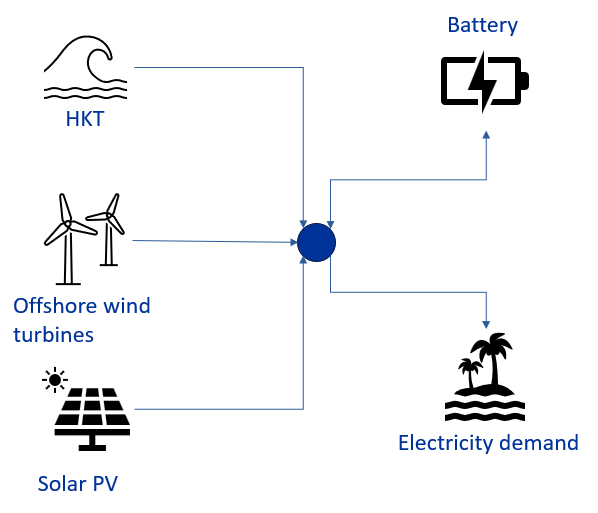Engineers at the University of Liège have conducted a concrete assessment of how best to deploy underwater turbines for electricity generation. Exploiting tidal currents could prove highly relevant for powering isolated sites, and in some cases for reducing the electricity bills of large facilities connected to the grid. This research is part of the SHINES project (Interreg NWE).
An article by the University of Liège:
https://www.fsa.uliege.be/cms/c_12771481/en/generating-electricity-from-tidal-currents
Imagine a wind turbine, but underwater. Driven by regular, predictable currents, hydrokinetic turbines convert tidal energy into electricity without depending on weather conditions. “Tides follow a natural clock, with well-defined schedules,” explains Raphaël Fonteneau, an engineer at ULiège. “Where wind and solar vary with gusts and clouds, the tide comes twice a day, relentlessly. For a power system operator, that regularity changes everything: you can plan production more accurately and avoid massive storage capacities.” A new study by ULiège engineers proposes a clear method for deciding, case by case, whether such turbines merit investment, either alone or combined with solar power and batteries.
The team compared three very concrete use cases. First, islands and isolated microgrids, where no subsea cable to the mainland is feasible and electricity must be produced locally and continuously. In this setting, tidal stability often allows for minimal battery storage, thereby limiting cost and complexity. Second, industrial plants connected to the grid. Here, the goal is not full autonomy, but lowering electricity costs by generating part of the demand on-site. Depending on the grid purchase price, turbine costs, and financing conditions, the optimal solution may be a tide–solar hybrid, with each technology complementing the other (solar by day, tides by day and night). Finally, independent producers intending to sell all electricity to the market. In this scenario, turbines still require further cost reductions to become fully competitive.
Diagram of the use case corresponding to the island not connected to the grid
© Université de Liège / Smart Grids Lab

“The very same turbine can be an excellent investment on an island heavily exposed to diesel prices, yet far less attractive just two harbors away if the current is weaker or financing is too expensive,” notes Loris Bigatton, a second-year bachelor’s student in engineering at ULiège and first author of the publication. “Hence the value of this approach: a decision-support tool that integrates local tidal data, storage options, possible solar coupling, and economic conditions to recommend a realistic mix.” The approach does not pit technologies against one another; it orchestrates what is available. At a given site, solar can cover daytime peaks, the tide sustains supply at night, and batteries smooth the remainder, yielding a more predictable electricity supply and less reliance on diesel gensets.
“Tidal turbines are not a one-size-fits-all solution, but they tick several essential boxes: predictability, low visual impact, and complementarity with solar,” concludes Prof. Damien Ernst. “Their relevance depends above all on location, needs, and financing conditions. With declining costs and well-sized projects, they can become a reliable pillar for electrifying remote sites and a sound investment for certain industrial consumers.”
This research is part of the SHINES project (Interreg NWE), which aims to develop applications to optimize energy from hydrokinetics and hydropower. ULiège engineers contribute modeling to improve construction techniques and make them more environmentally friendly. The project also includes developing solutions for off-grid dwellings.
The tidal kite is an example of a fairly innovative device developed as part of the SHINES project.
© TidalKite™ system - SeaQurrent

The tidal kite is an example of a fairly innovative device developed as part of the SHINES project. | © TidalKite™ system
Loris Bigatton, first author ... and still a student!
Behind the first author of this study is a ULiège engineering student who has just entered the second year of his bachelor’s degree, an uncommon achievement worth highlighting. Under the supervision of researchers at the Smart Grids Lab, Loris Bigatton led the model development, tested the scenarios (isolated island, grid-connected plant, market-oriented producer), and translated the results into clear recommendations for decision-makers. His work exemplifies research-based education: starting from a very concrete question and answering it with a rigorous method that is useful to engineers and communities alike.
Cover: ©️ Image generated by artificial intelligence